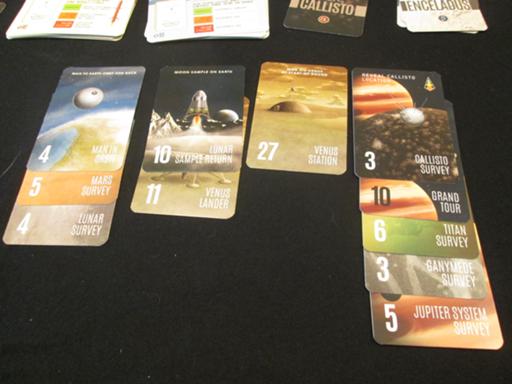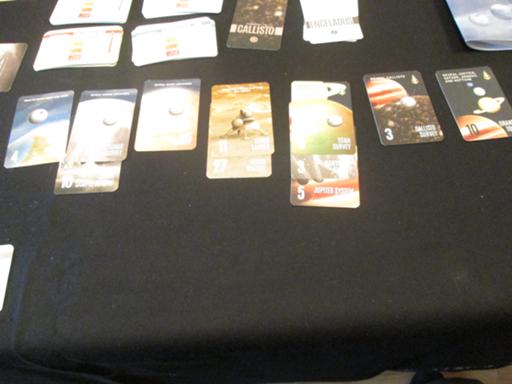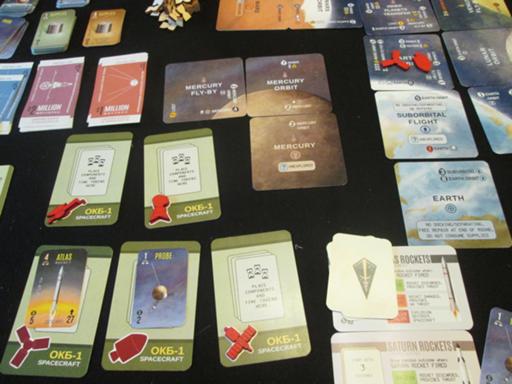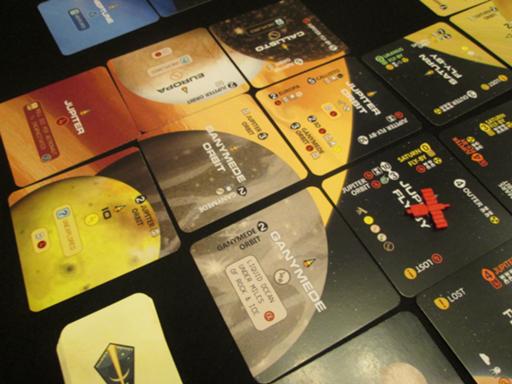I know, I know. I got my copy of
Leaving Earth: Outer Planets
back in July, and I haven't had it to the table until now. I was
hoping to get some suckers to play it with me, but instead I ran a
solo game on a grey Sunday afternoon. (I haven't played any version of
Leaving Earth solo before.)
Images were taken on the Powershot A1300 in "custom white balance"
mode, under halogen incandescents; I thought it did quite a decent
job. As usual, click on images to get the bigger version;
cc-by-sa on
everything.
Setup
Setup is a distinctly longer process than it used to be, with
extra equipment and advancements, a new astronaut type, and lots more
extraterrestrial samples.

This is to be a Hard game, so I remove the Non-Explorable Outer
Planets missions that are worth more than 24 points before dealing.
My initial mission selection is:
- Man in Orbit
- Lunar Survey
- Lunar Sample Return
- Venus Lander
- Venus Station
- Mars Survey
- Jupiter System Survey
- Callisto Survey
- Ganymede Survey
- Titan Survey
- Grand Tour

Pre-game planning
Clearly I need to shoot for Venus Station, which will give me 38 out
of the 44 required points… if it works. If Venus is un-landable, which
is a 50/50 chance, then the needed points drop to 25, and I'll need at
least one Outer Planets mission to win (plus whatever explorable
missions cut in after that), so I'll probably want a "big" mission to
Jupiter. So it looks as if I should get a probe to Venus ASAP to find
out what my strategy should be.
I am going to be putting a lot of stuff into Earth Orbit so I'll go
for Saturns quite early.
Rearranging the missions by location (and making only a minor error);

1956
Buy: Saturn advancement, Saturn Rocket.
1957
Launch Saturn. Outcome is Minor Failure; I pay $5 to remove it, and I
can use that Saturn again. With $20 left, I buy Rendezvous and Landing
advancements.
The Saturn is repaired at end of year.
1958
Launch Saturn. Outcome is Major Failure; I pay $5 to remove it. With
$20 left, I buy the Atlas advancement, one Atlas and two probes.
1959
Buy Saturn. Assemble Saturn + Atlas + probe.
Launch to Earth Orbit. Saturn outcome is Success; removed without
charge.
Attempt to separate Atlas and Probe: Success, remaining $10 to remove.

1960
Attempt to rejoin Atlas and probe: minor failure, $5 to remove, damage
Atlas.
Attempt to rejoin Atlas and probe: success, free removal.
Separate Atlas and probe.
Buy Surveying advancement.
From probe, attempt to Survey solar radiation. Success, free removal.
Solar radiation is level 1.
Attempt to land probe: success, remove for $10.
1961
Attempt to land damaged Atlas: major failure, $5 to remove.
Buy an Atlas, put it under a probe, launch to sub-orbital flight:
Success: $10 to remove.
The probe attempts a landing from sub-orbital flight: success, free
removal.
$5 remains. Buy another Atlas.
1962
Buy an Atlas. Launch it. Major failure, $5 to remove.
Launch the other Atlas to Earth Orbit, with a probe on it. Success,
free removal. (I actually needed two Atlas here. But I don't think
it made a huge difference in the end; I could have bought the Junos in
1963 instead.)
Buy Juno advancement and five Junos.
1963
Launch a Juno: success, $10 to remove.
Launch a Juno: major failure, $5 to remove.
Launch a Juno: success, free removal.
Buy two Atlas.
1964
Buy a Saturn.
Assemble Atlas and Juno onto Saturn.
Launch directly to Earth Orbit.
Rendezvous: join to probe sitting in orbit since 1962.
Manoeuvre: burn Atlas to push Juno and Probe to Inner Planets Transfer
(⌛).

Buy Ion Thrusters advancement. (I can't waste money waiting to find
out what's at Venus; I have to start developing now. So I am betting
against a landable Venus. If I do set up Venus Station I'll need Life
Support and Re-Entry. But I can go for the Grand Tour with two Ions
and a probe if I launch in 1972. And I like Ions anyway.)
1965
Remove ⌛ from the Venus probe; it arrives at Inner Planets Transfer.
Venus probe burns Juno to move to Venus Fly-By with ⌛.
Buy a Saturn and an Ion thruster.
1966
Remove ⌛ from the Venus probe; it arrives at Venus Fly-By.
Venus probe surveys Venus. Supplies are available! OK, I bet the wrong
way; I could win without any Outer Planets missions or Ions. But now
that I have them, I'm going to use them.
Buy Aerobraking advancement.
Venus probe attempts aerobraking. Success, $10 to discard; in Venus
orbit.
Venus probe lands on Venus: Venus Lander complete, 11 points scored.

At this point I intend to complete Venus Station and the Grand Tour,
because I'm being non-gamist. I could win at this point without
touching the Outer Planets at all, just by bringing a sample back from
the Moon. But that would be dull. (See
this thread
at BGG for some other answers to this problem, and I'll mention this
again at the end.)
My current Venus mission plan requires me to deliver two probes and
three astronauts in an Apollo to Venus Fly-By: then the probes finish
off aerobrake testing and the capsule is safe. That's mass 5 from
Inner Planets Transfer to Venus Fly-By (plus one Supply), which I can
push with an Atlas which is another 4 mass; which is mass 10 (plus one
Supply) from Earth Orbit to Inner Planets Transfer, which I can push
with… most efficiently a Proton, most cheaply a Soyuz. I don't really
fancy developing those. What about Ions? Payload 6 through difficulty
2 will need 4 Ions, payload 7 through difficulty 3 will need 10;
payload 8 and 2 years through diff 3 will need 4. Expensive, but I've
got time to do it, and maybe even to bring the Ions back for another
mission.
And with any luck I can put both missions (Venus Station and the Grand
Tour) on a single double-Saturn stack. (Not quite, as it turned
out.)
Recruit a medical astronaut. First off the stack is Nikolayev.
1967
Research Life Support. Buy a Saturn.
1968
Research Re-Entry.
Buy three Vostok, an Apollo and a Galileo.
1969
Buy two Ions and a Galileo.
1970
Assemble 3 Vostok, 3 Ion, 2 Galileo, Atlas on a double-Saturn stack
and boost to Earth Orbit.

Separate first Ion. Fire to Lunar Orbit. Success, $10 to remove.
Separate second Ion. Fire to Lunar Orbit. Success, $10 to remove.
Separate third Ion. Fire to Lunar Orbit. Success, free removal
1971
First life support draw: success, discard for $10.
Second life support draw: success, discard for $10.
Third life support draw: success, free discard.
(Another error - I misread the altered turn sequence and tested life
support at the start of the year rather than saving funds at the end.
Again, doesn't make a significant difference.)
All Ions arrive at Lunar Orbit.
Join all three Ions, fire back to Earth Orbit.
Recruit one more medic (Bykovsky).
1972
Three Ions arrive in Earth Orbit.
Buy one Ion and two Atlas; use the latter to get the former into Earth
Orbit.
Rendezvous everything that's in Earth Orbit, then peel off two
Galileo, four Ions and an Atlas to make "Zhar-ptitsa" (leaving three
Vostok).
Burn Atlas plus four Ions to move Zhar-ptitsa to Inner Planets
Transfer + ⌛. (Thrust 27+4×5=47 against mass 12×difficulty 3=36.)

Recruit one more medic (Tereshkova).
1973
Zhar-ptitsa arrives at Inner Planets Transfer.
Zhar-ptitsa (which is now four Ions + 2 Galileo) burns to Venus
Fly-By.
Separate and re-enter first Vostok: success, discard for $10.
Separate and re-enter second Vostok: success, discard for $10.
Re-enter third Vostok: success, free discard.
Buy 5 Supplies.
1974
Zhar-ptitsa arrives at Venus Fly-By.
Buy Saturn and Ion.
Zhar-ptitsa burns to Jupiter Fly-By.
1975
Zhar-ptitsa arrives at Jupiter Fly-By.
First Zhar-ptitsa-Galileo surveys Jupiter: radiation hazard and beta
mission, which is an orbiter.
Second Zhar-ptitsa-Galileo surveys Ganymede. 3 points, and an alpha
mission of Ganymede Lander.

Now I'm facing Jupiter System Survey, Callisto Survey, Jupiter Orbiter
and Ganymede Lander. Putting a probe on Ganymede from Jupiter Orbit
will take three Junos. (This is wrong, as I noticed later.)
Jupiter Fly-By to Jupiter Orbit adds one Atlas, so I have a mass-12
spacecraft to deliver to Jupiter Fly-By. Three Ions will push it there
from Venus Fly-By in a slingshot year and that's two years from Inner
Planets Transfer, and three years from Earth Orbit. Six years, and I
need to hit a Jupiter slingshot one year before the end. Say that's
the 1984 sling, I need to launch the mission of three Ions, Atlas, 3
Juno and Probe in 1979.
Buy Saturn and Ion.
The four Ions detach from Zhar-ptitsa and burn for Outer Planets
Transfer. Zhar-ptitsa needs no more delta-V, and I can use those Ions
again.
Zhar-ptitsa "burns" for Saturn Fly-By.
1976
Buy two Ions, five Supplies.
1977
Ion cluster arrives at Outer Planets.
Ion cluster burns for Earth Orbit with aerobrake.
Zhar-ptitsa-A surveys Saturn: débris and an alpha mission, Saturn
Orbiter revealed.
Zhar-ptitsa-B surveys Titan: supplies and an alpha mission, Cloud
Explorer. (And 6 points.)
Aerobraking an Explorer on Titan from Saturn Orbit will take a Juno.
Add a Probe and that's mass 4 to Saturn orbit. Two more Junos get me
out of Saturn Fly-By, free from Jupiter Fly-By if I leave in 1984, but
I can't stack that with Venus. So I need to leave Outer Planets
Transfer in 1982 with 4 Ions, Earth Orbit in 1980 on a two-year 3-ion
burn.
Zhar-ptitsa "burns" for Uranus Fly-By.
Buy two Ions, Explorer (for Titan).
1979
Ion cluster arrives at Earth Orbit and separates for aerobrake.
First Ion: damaged, pay $5
Second Ion: damaged, pay $5
Third and fourth Ions auto-succeed.
The damaged Ions are unaffected by atmospheric re-entry; I deorbit
them both anyway.
Now my Venus Station mission has got lighter: just the Apollo plus
supplies, since I don't need the aerobrake test vehicles. 3 Ions for 1
year gets me from Inner Planets Transfer to Venus Fly-By, 3 Ions for 2
years from Earth Orbit to Inner Planets Transfer, so that's Apollo, 3
Ions and 3 Supplies for mass 9.
So my remaining planned missions are:
Jupiter/Ganymede: must launch this year, 3 Ions, 3 Juno, Atlas, Probe
= 11 mass to Earth Orbit
Saturn/Titan: launch in 1980, 4 Ions, Explorer, 3 Juno, Probe = 9 mass
to Earth Orbit
Venus Station: by 1983, Apollo, 3 Supplies, 3 Ions = 9 mass to Earth
Orbit
Buy 5 Juno, Atlas, Probe.
On a double Saturn, launch the Jupiter/Ganymede and Saturn/Titan
missions (less the two Ions which I'll pick up in orbit).
Combine with the two Ions in orbit. Split off Jupiter/Ganymede
("Krasniy"). Remnant is Saturn/Titan ("Velikan").
Krasniy burns 3 Ions for 3 years vs total mass 11 to move to Inner
Planets Transfer.

2 Ions on Earth auto-repaired.
1980
Velikan burns 4 Ions for 3 years vs total mass 9 to move to Outer
Planets Transfer.
Buy Saturn.
1981
Buy Saturn, Ion.
Assemble Apollo plus astronauts, 3 Supplies, 3 Ions ("Bogatyr") on
2-Saturn stack to Earth Orbit. (Which scores me Man in Orbit (4),
which I didn't notice at the time.)
I finally explore Sub-Orbital Flight with a human: incapacitation on
1-3. Rolls are 6, 7, 5.
Bogatyr burns 3 Ions for 2 years to Inner Planets Transfer.
Radiation hazard Nikolayev: 8, OK
Radiation hazard Bykovsky: 4, OK
Radiation hazard Tereshkova: 3, OK
1982
Zhar-ptitsa arrives at Uranus Fly-By, surveys Uranus.
Zhar-ptitsa "burns" for Neptune Fly-By.
Krasniy arrives at Inner Planets Transfer.
Bogatyr crew consumes one supply.
Krasniy burns 3 Ions for 2 years vs total mass 11 to move to Venus Fly-By.
1983
Bogatyr crew consumes one supply.
Bogatyr arrives at Inner Planets Transfer.
Velikan arrives at Outer Planets Transfer.
Velikan burns 4 Ions for 3 years vs total mass 9 to move to Saturn Fly-By.
Bogatyr (now mass 7) burns 3 Ions for 1 year to Venus Fly-By.
Radiation hazard Nikolayev: 2, OK
Radiation hazard Bykovsky: 2, OK
Radiation hazard Tereshkova: 4, OK
1984
Bogatyr crew consumes one supply.
Bogatyr arrives at Venus Fly-By.
Krasniy burns 3 Ions for 1 year vs total mass 11 to move to Jupiter Fly-By.
Bogatyr aerobrakes to Venus orbit.
Bogatyr leaves Ions in Venus orbit, lands on Venus.
1985
Venus Station achieved, 27 points.
Krasniy arrives at Jupiter Fly-By.
Krasniy separates Ions.
Ions burn for Outer Planets Transfer.
Krasniy (mass 8) burns Atlas to aerobrake into Jupiter orbit, scores
Jupiter Orbiter (9).
Krasniy telescopically surveys Callisto, Europa and Io to score
Callisto Survey (3) and Jupiter System Survey (5). I draw Io Lander
and Advanced Europa Survey. I could retask from Ganymede to Io, but
it's fewer points…
… actually, I now realise that to land on Ganymede I need to go from
Jupiter Orbit to Ganymede Orbit to Ganymede, and I don't have the
rockets for that, so I will in fact land Krasniy on Io (12).
1986
Zhar-ptitsa arrives at Neptune Fly-By.
Velikan arrives at Saturn Fly-By.
Zhar-ptitsa surveys Neptune, completing Grand Tour (10).
Velikan splits off 4 Ions, which burn for Outer Planets Transfer.
Velikan burns two Junos to aerobrake into Saturn orbit, scores Saturn
Orbiter (13).
Velikan separates Probe.
Velikan burns 1 Juno to aerobrake to Titan orbit.
(I think I may have needed to check the Saturn hazard here, which is
a débris belt. Rolled a 3 after the fact, so that would be OK.)
Velikan, which is now just an Explorer, lands on Titan to score Titan
Cloud Explorer (22).
In the end I have scored 125 points, with 43 still on the table: 74%,
where victory is taken as 50%. I also completed all the revealed
non-explorable missions, which is a variant extra win condition that I
think I favour.

Final Thoughts
-
There's still time pressure in a solo game, but much less than in
the competitive multi-player version. I never had to risk human
life, or even the success of a "real" mission; the worst
consequences I might have had were the occasional lost probe or ion
thruster.
-
Usually I develop all the rockets. Got away without Soyuz this time.
(Or Proton.)
-
The "quick game" starts in 1966 with two fully-tested advancements.
By the time I got to 1966, I had Saturn, Atlas, Juno, Surveying,
Landing and Rendezvous fully tested.
-
I hardly ever use the Fly-By locations in standard game play, unless
there's a Survey but no Landing mission to be scored. But having
aerobraking makes them very much more useful.
-
Yes, all right, I did take about four and a half hours of real time
from end of setup to end of game. But I was interrupted by food and
beer (this writeup brought to you by Hoegaarden), I was working out
mission plans and typing up what happened as I went, and I didn't
feel the game overstayed its welcome. I suspect many players might,
though.
Now I'd really like to try this again with opposition. Maybe with my
prototype Nuclear Rockets add-on…
Comments on this post are now closed. If you have particular grounds for adding a late comment, comment on a more recent post quoting the URL of this one.